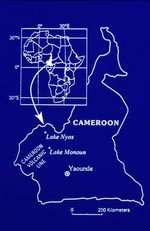Lake Nyos
|
|
Lake Nyos is a lake in Cameroon, West Africa. It lies within an old volcanic crater in the Oku Volcanic Field. It is most well known because of the Lake Nyos tragedy, in which a large amounts of carbon dioxide in solution in the lake was suddenly released, killing up to 1800 people in villages near the lake by asphyxiation.
| Contents |
Formation and geological history
Lake Nyos fills a roughly circular maar, an explosion crater caused when a lava flow interacts violently with groundwater. The maar is believed to have formed in an eruption about 400 years ago, and is 5,900 feet (1,800 m) across and 682 feet (208 m) deep. The area has been volcanically active for millions of years - after South America and Africa were split apart by plate tectonics about 110 million years ago, West Africa also experienced rifting, although to a lesser degree. The rift is known as the Mbéré Rift Valley, and crustal extension has allowed magma to reach the surface along a line extending through Cameroon. Mount Cameroon also lies on this fault line. Lake Nyos is surrounded by old lava flows and pyroclastic deposits.
Gas saturation
Lake Nyos is one of only three lakes in the world known to be saturated with carbon dioxide - the others are Lake Monoun, also in Cameroon about 100km away, and Lake Kivu in Rwanda. A magma chamber beneath the region is an abundant source of carbon dioxide, which seeps up through the lake bed, charging the waters of Lake Nyos with an estimated 90 million kilograms of CO2 annually.
Lake Nyos is thermally stratified, with layers of warm, less dense water near the surface floating on the colder, denser water layers near the lake's bottom. Over long periods, carbon dioxide gas seeping the cold water at the lake's bottom is dissolved in great amounts.
For most of the time, the lake waters are stable and the CO2 remains in solution in the lower layers. However, over time the water becomes supersaturated, and if an event such as an earthquake or volcanic eruption occurs, large amounts of CO2 may suddenly come out of solution.
The 1986 disaster
Cow_killed_by_Lake_Nyos_gasses.jpg
In 1984, a sudden outgassing of CO2 had occurred at Lake Monoun, killing 37 local residents. However, a similar threat from Lake Nyos was not anticipated. On August 21, 1986, an event occurred at Lake Nyos which triggered the sudden release of about 1.6 million tonnes of CO2. The gas rushed down two nearby valleys, displacing all the air and suffocating up to 1800 people within 20 km of the lake.
It is not known what triggered the catastrophic outgassing. Most geologists suspect a landslide, but some believe that a small volcanic eruption may have occurred on the bed of the lake.
Degassing
The scale of the disaster led to much study on how a similar occurrence could be prevented. Estimates of the rate of carbon dioxide entering the lake suggested that outgassings could occur every 10-30 years.
The solution proposed by scientists to the threat posed by Lake Nyos was that pipes should be extended into the lower regions of the lake, allowing a controlled and continuous outgassing. International efforts have since installed a pipe running from the surface anchored to a raft that allows the deeper areas of the lake to release their CO2 to the surface in controlled small amounts. It is hoped this will reduce the maximum levels of CO2 in the future, and prevent any possibility of the lake turning over. Degassing began in 2001 and is continuing steadily.
See also
References
- Cotel A (1999), A trigger mechanism for the Lake Nyos disaster, American Physical Society, Division of Fluid Dynamics Meeting, November 21-23, 1999
- Sano Y., Kusakabe M., Hirabayashi J. et al (1990), Helium and carbon fluxes in Lake Nyos, Cameroon: constraint on next gas burst, Earth and Planetary Science Letters, v. 99, p. 303-314
- Sano Y., Wakita H., Ohsumi T., Kusakabe M. (1987), Helium isotope evidence for magmatic gases in Lake Nyos, Cameroon, Geophysical Research Letters, v. 14, p. 1039-1041
External links
- http://perso.wanadoo.fr/mhalb/nyos/
- http://www.biology.lsa.umich.edu/~gwk/research/nyos.html
- BBC News 'On This Day' article (http://newssearch.bbc.co.uk/onthisday/hi/dates/stories/august/21/newsid_3380000/3380803.stm)
- BBC news article about the degassing of Lake Nyos (http://news.bbc.co.uk/1/hi/world/africa/1155057.stm)
- BBC Horizon episode Killer lakes (http://www.bbc.co.uk/science/horizon/2001/killerlakes.shtml)
- Volcano World information (http://volcano.und.nodak.edu/vwdocs/volc_images/africa/nyos.html)
- USGS information (http://vulcan.wr.usgs.gov/Glossary/Lakes/description_volcanic_lakes_gas_release.html)de:Nyos-See


